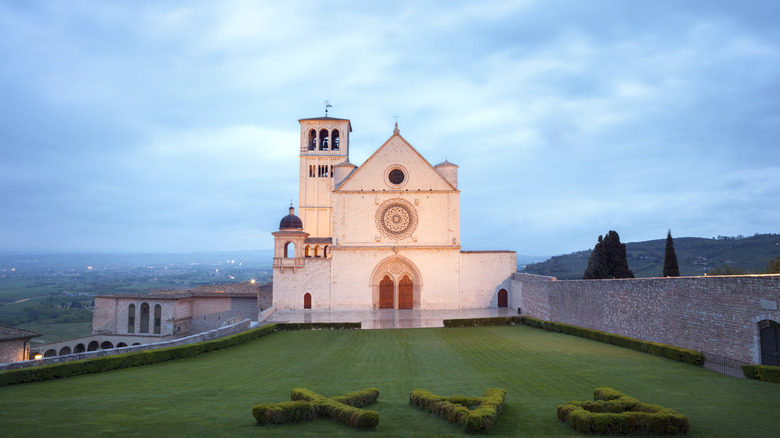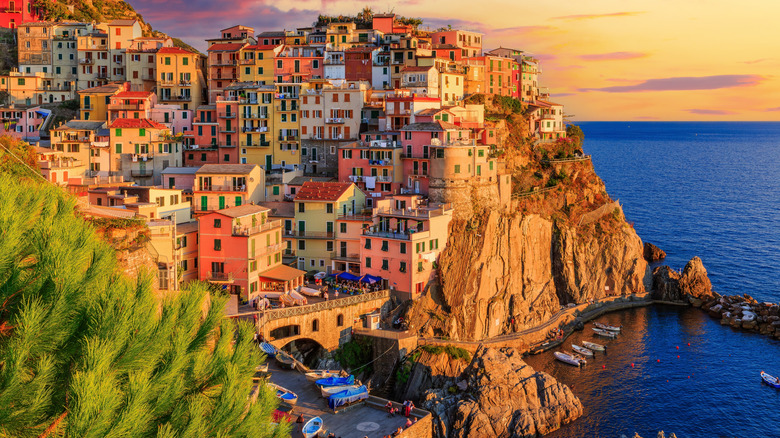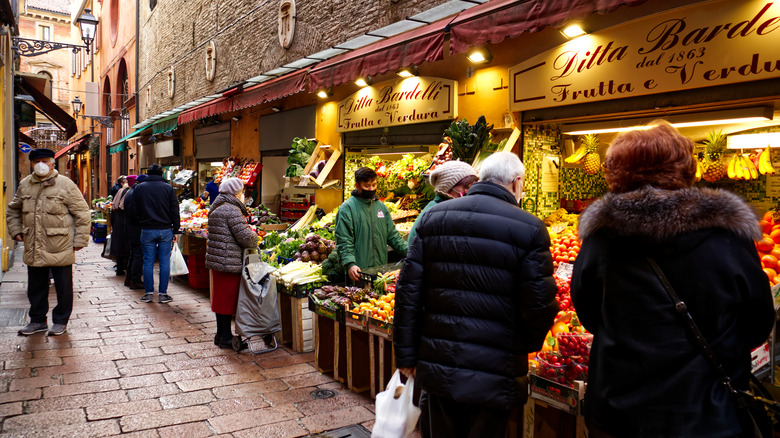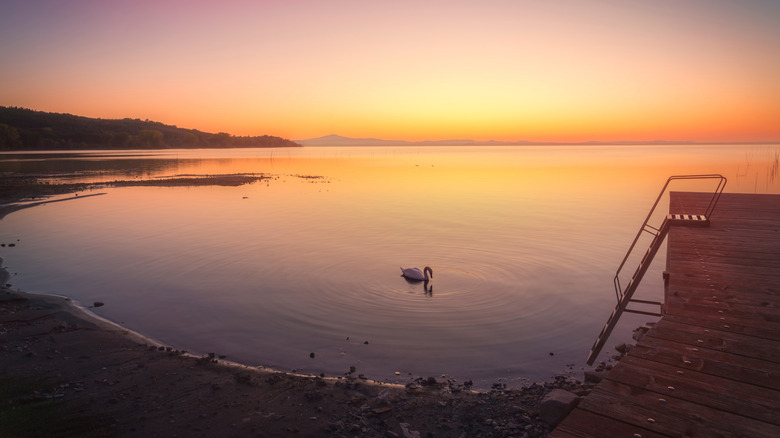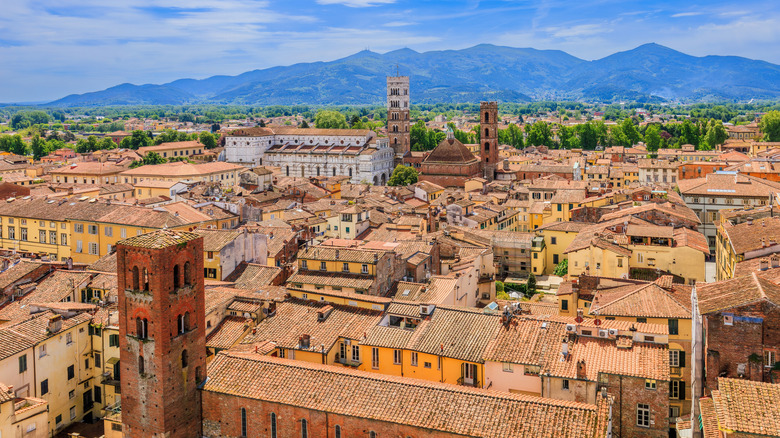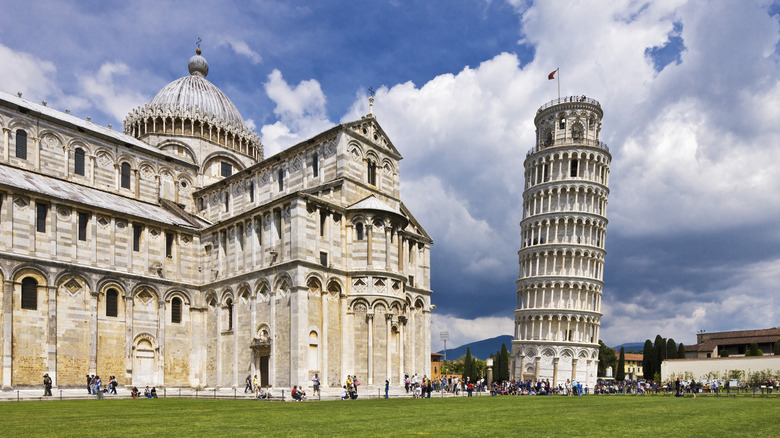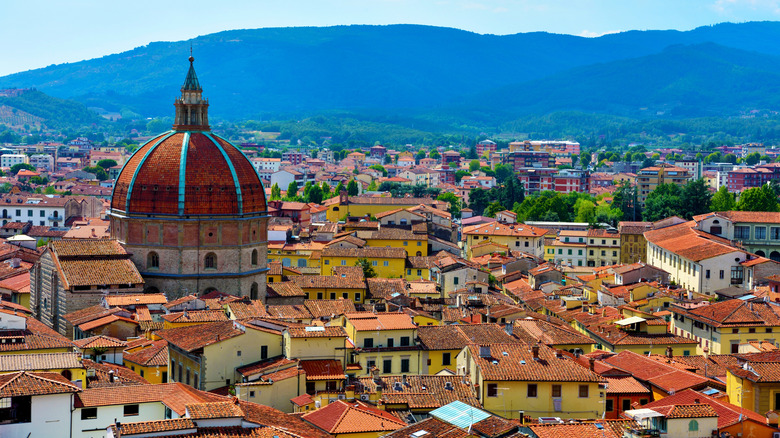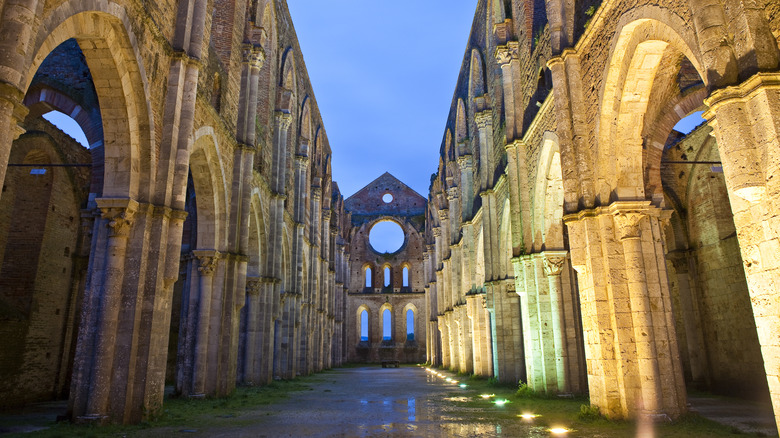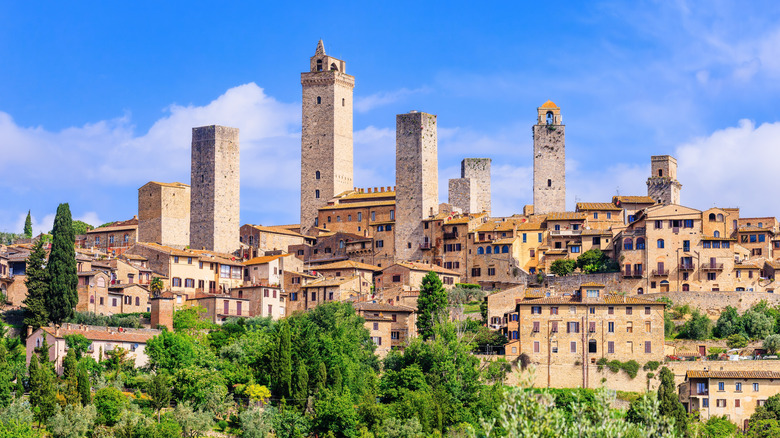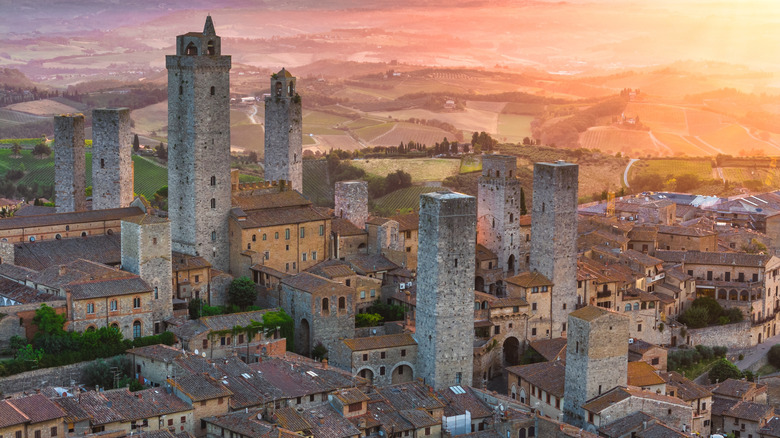The Best Day Trips From Florence Every Traveler Should Consider, According To Travel Guides
We already know why you're one of the millions of people jumping out of your seat at the thought of visiting Florence, Italy. As the birthplace of the Renaissance, priceless works of art are on every corner, like Michelangelo's "David," housed at Galleria dell'Accademia, and the showstopping Cathedral of Santa Maria del Fiore. It's easy to visit this preserved piece of history repeatedly. You'll always find a new sight or fresh perspective of an old favorite from its cobblestone paths. Those include these must-visit spots in Florence. But there's more to enjoy right outside Florence, too. The city is surrounded by countless medieval villages, culinary hotspots, and historic epicenters, easily reachable within a short drive or train ride from Florence. Plus, they are usually less crowded than the Tuscan city.
With so many options, Explore rounded up the best day trips from Florence that every traveler should consider, ranging from what's been nicknamed "Italy's food valley" to five remote seaside towns connected by rail. To create this list, we only included Italian destinations within two-and-a-half hours by car or train from Florence. Here's when to buy your train tickets in Italy to get the best deals. These destinations also have the most unique and iconic sites, as well as the most options for activities, according to travel guides and bloggers.
Arezzo
Want the art history of Florence and the ancient excitement of Rome without the crowds? Take a 40-minute train ride to Arezzo, which has the best of both Italian cities in one destination. As the former home of artist Piero della Francesca, Arezzo has several works that will have art fans swooning. Some are at the Basilica di San Francesco, which has several frescoes painted by Francesca, including the famed "Legend of the True Cross." The frescoes in this church have made it through warfare and natural disasters and remain in great condition. You can also see a fresco of St. Mary Magdalene that Francesca painted inside the Gothic-style Duomo di Arezzo, which is accompanied by stained glass windows.
Arezzo was also once the home of Giorgio Vasari, who is known as the first art historian on the planet and is the creator of the Uffizi Galleries in Florence. In Arezzo, visitors can tour his house, which is now a museum. You can also buy art to take home with you thanks to Arezzo's antique market, which is the biggest and oldest antique market in the country. However, Arezzo will appeal even if you're more of a stick figure maven than an artist. It has an ancient Roman amphitheater within Museo Archeologico, which could once entertain 10,000 people. Visitors can see where the best entertainment in the city once took place, as well as Etruscan and Roman artifacts.
Assisi
As the home of the Vatican and a hub of Catholicism, Italy has long been the epicenter of religion. But if you're interested in religious history in Italy and only visit the Vatican, you're missing out. Trade your trip to Rome for a two-hour train ticket to Assisi from Florence. It is the birthplace of Catholicism's most renowned saints: Saint Catherine of Siena and St. Francis, the creator of the Franciscan Order.
Visitors can see St. Francis' tomb at the Basilica di San Francesco d'Assisi. Dating back to 1228, the basilica has two fresco-filled churches, one portraying scenes from St. Francis' life and the other with his crypt. Assisi has many other churches as well. These include Santa Maria degli Angeli, which houses St. Francis' former home, and San Damiano Church, where the religious figure heard the voice of God. On your visit to this Catholicism-laden town, you might see monks and other religious pilgrims.
Amazingly, Assisi doesn't look that different from the time of St. Francis. It's one of the most unspoiled medieval towns on the planet, so much so that the entire area is a UNESCO World Heritage site. To see it all from above, hike to Rocca Maggiore, a 14th-century castle that overlooks Assisi. From here, you'll be dazzled by the town's startling white look, as many of its structures are made of local limestone.
Cinque Terre
Move over, Amalfi Coast. You don't have to journey from Florence to the Amalfi Coast to get a taste of Italy's shoreline. Instead, take the two-and-half-hour drive from Florence to Cinque Terre, which are five charming (albeit crowded) towns on the Ligurian Sea connected by rail. Full of colorful cliffside buildings surrounded by turquoise waters on one side and foliage on the other, Cinque Terre is so beautiful that it inspired the Disney film "Luca."
Since it's the first train stop of the bunch, you'll likely start your visit in Riomaggiore. The town has several upscale restaurants and a castle that showcases panoramic views of Riomaggiore below. It's also where the legendary Lover's Lane (Via dell'Amore) begins, which treks to the next town of Manarola. It is known as the most romantic town in Cinque Terre due to its stunning cityscape. It's also thought to be the oldest Cinque Terre town.
If you're looking to take a dip, you should hike or take the train to Monterosso al Mare, which, unlike its Cinque Terre counterparts, has a sandy — not rocky — beach. Next, there's Corniglia, which isn't adjacent to the sea like the other towns. However, it makes up for it with local Vernaccia di Corniglia wine. End your day at Vernazza, which can be the most crowded Cinque Terre town due to its beauty and historical importance.
Emilia-Romagna
The hardest part about visiting Emilia-Romagna for a day trip is picking which town to explore and what to eat. This region is a 40-minute train ride from Florence, dubbed "Italy's food valley. Emilia-Romagna is the birthplace of Parmigiano Reggiano cheese, Modena balsamic vinegar, Prosciutto di Parma, and other famous Italian eats. It's still the best place to get them.
Start your food tour in Bologna, where you can buy those items at the Quadrilatero, the oldest food market in the city, to take home with you. With even more history under its ever-widening belt, Bologna is also home to the oldest university on Earth and the longest portico on the planet (a UNESCO World Heritage site.) Another foodie hotspot in Emilia-Romagna is Modena, home to balsamic vinegar. In the city's hills, where production facilities lie, visitors can meet the artisans who create this delicacy.
There's also a chance to meet one of the best chefs in the world (or at least taste his food) at the 3-star Michelin restaurant Osteria Francescana, which has chef Massimo Bottura at its helm. Also in Modena, check out the Ferrari factory, which showcases how the brand's high-end cars are made, and book a Lamborghini test drive. Then, head to Parma, the birthplace of Prosciutto di Parma and Parmigiano Reggiano. Visitors can take Parmigiano Reggiano factory tours to see the delicious process firsthand.
Lake Trasimeno
Visiting one of the picturesque lakes in Italy, which often have a romantic and relaxing atmosphere and are surrounded by medieval villages and rolling hills, is a must. But that doesn't mean you have to endure the crowds or the four-hour travel time from Florence to see the well-known Lake Como. Just an hour-and-a-half drive from Florence is Lake Trasimeno. It is just as beautiful and romantic but not nearly as jam-packed as Lake Como.
It's so romantic that according to legend, it was created from the tears of the lake nymph Agilla as she grieved for her lost love, Prince Trasimeno. But you won't be crying on your trip to this age-old lake that dates back to Paleolithic times. Since it's only about 21 feet deep (yet nearly as large as Lake Como), the water stays warm, which makes it perfect for swimming, windsurfing, wakeboarding, and diving. It's also a popular boating and fishing spot.
Towns dot the area, including Passignano, which has the most action for visitors since it's full of restaurants, bars, and fun activities. It's also rich in history; the town is home to a Roman castle rebuilt as far back as the fifth century. The best time to visit Passignano is during the annual Palio delle Barche festival in late July. It reenacts a late 15th-century battle. During this wild time, 160 people compete in various games.
Lucca
If you're going on a day trip from Florence to Pisa, you must stop at Lucca, which is just a 30-minute train ride from Pisa (making for an hour-and-a-half-long total trip from Florence). Lucca is a quiet and quaint destination because it's surrounded by charming 40-foot-high walls that look out over the Tuscan countryside.
Visitors can rent bikes and trek the 3 miles around the walls, stopping to check out the scenery and enjoy a one-of-a-kind ride. You can also see beautiful views from the top of Guingi Tower, one of the city's last remaining tower houses. It's just one of the reasons why tourists are flocking to Lucca. Once you return your bike, you'll realize why Lucca has another claim to fame as the "City of 100 Churches."
One of its most popular is Sant'Alessandro, which dates back to 893 BC and houses the crypt of St. Alexander I. It was one of the first structures in the city made in a Romanesque style. Those interested in different kinds of art will also get a kick out of the Puccini Museum, the former home of renowned Italian composer Giacomo Puccini. The museum houses the piano on which he composed "Turandot" and Maria Jeritza's costume, which she wore while singing "Turandot" in New York City.
Pisa
If you didn't take a photo pretending to hold up the Leaning Tower of Pisa, did you even go to Italy? Florence visitors should never have to ask themselves that question since Pisa is just an hour-long train ride away. The Leaning Tower of Pisa was completed in 1399 after taking over 200 years to build. Unfortunately (or fortunately for tourists), the tower was leaning before the work was completed.
The ground it sits upon is skewed, leading it to lean about 5 degrees, despite nearly two decades of efforts to fix it. Also on its plot on the Piazza dei Miracoli, a UNESCO World Heritage site, are the Cathedral, Battistero di San Giovanni, and Camposanto Monumentale. These all make Pisa a living medieval architectural history museum, as these sites are just as worth visiting as the Leaning Tower — albeit less Instagram-worthy.
The Battistero di San Giovanni is the largest baptistery in the country, dating back to 1152. It's also a crazy place to hear acoustics, as presented by staff members every half-hour. Its next-door neighbor, Cathedral di Santa Maria Assunta, is just as inspiring as it is gorgeous. The cathedral was damaged by fire in 1595, but it remains remarkably exquisite, featuring 14th-century mosaics and Arab influences. After picking your jaw off the floor due to this building's beauty, head to the north side to see the "Devil's Nails." According to legend, the number of these nails is everchanging.
Pistoia
Tuscany is a green paradise of rolling hills and lush foliage, but it's easy to forget that while in the bustling city of Florence. However, you won't be able to forget it in Pistoia. Just a 35-minute train ride from Florence, Pistoia is where plants throughout the continent are sourced. The hidden gem of a town always keeps its green thumb in mind, especially through its Wednesday afternoon organic market, which showcases about 10 local farms and food artisans. You can also taste the harvest of the local farms' at Podere Macolo, a spot that conducts free organic olive oil tastings.
Away from the sunshine, a whole other world exists underneath Pistoia. Visitors can tour underground tunnels previously used for water supply beneath the city's center. If you're not claustrophobic, reserve a seat at Teatrino Gatteschi, the smallest theater in the country. With just 15 seats, it offers an intimate and historical experience, as it dates back to 1707. For a more traditional theater experience, buy tickets for a performance at Theater Manzoni.
San Galgano Abbey
Have you ever watched the children's classic movie "The Sword in the Stone?" Just an hour-and-a-half drive from Florence, you can see the real thing. After a sword dating back to the 12th century was wedged in a stone in what was deemed a miracle of God, the San Galgano Abbey was built nearby. According to legend, it all began when knight Galgano Guidotti, a playboy of his time, saw Archangel Michael twice in his dreams.
Guidotti was then inspired to leave his womanizing ways behind and become a Christian, but it wasn't an easy choice as he had to leave his girlfriend, Polissena. His fellow knights, who mocked his conversion, didn't make it easy either. In anger, he thrust his sword into a stone, and miraculously, it stuck. It also appeared in the shape of a Holy Cross and was thought to be a sign from God for Guidotti to give up violence and war.
Guidotti started building the San Galgano Abbey to memorialize the miracle in 1181, but he died that same year. The abbey was completed four years later. Although today, the abbey lacks a roof due to a lightning strike, people can visit, as well as the neighboring retreat of Monte Siepi, which houses the sword. You can even try to pull the sword out of the stone.
San Gimignano
If you've been traveling around Tuscany, you've likely already passed by San Gimignano and were left gazing at its commanding hilltop presence and 14 medieval towers. It's worth stopping the car, though, considering San Gimignano is only an hour's drive from Florence. It's also one of the small towns in Italy that are just as beautiful as Florence. Once inside city lines, you'll find that those towers are even more iconic than your first glance led you to believe.
Known as the Manhattan of the Middle Ages, San Gimignano is reputed for its towers, and it once had 72. Although tens of them were demolished long ago by domineering Florentines, the fact that San Gimignano still has 14 towers is a rarity. As such, the town was named a UNESCO World Heritage site in 1990.
Visitors can climb only one tower, which stands at 200 feet tall. While here, also visit Piazza della Cisterna, the main square of San Gimignano, as well as the Romanesque cathedral in Piazza del Duomo. Inside, you'll see 14th-century Sienese Gothic art. But for the best San Gimignano experience, forego the tourist-ridden crowds of the daytime and visit in the late afternoon for a magical Tuscan evening.
Siena
Just a 45-minute drive from San Gimignano, some Florence tourists divert their San Gimignano day trips to another iconic Tuscan town — Siena. An hour-and-10-minute drive from Florence, Siena is another beautifully preserved medieval town with a quaintness that tourists won't find in Florence. It's unsurprising that even Rick Steves says Siena has the best medieval city experience.
The most iconic spot in this blast-from-the-past town is the Piazza del Campo, a wide-open, half-moon-shaped space. It's the home of several of Siena's most historical structures, as well as its most significant event — the Palio di Siena. A biannual horse race held since 1633, the Palio is one of the most popular events of its kind in the country. If you can visit during Palio, which is every July 2 and August 16, you'll experience Siena at its best.
Even if your trip doesn't align with the Palio, you'll still find plenty of medieval architecture and history to gawk at in the city. Siena has one of the tallest towers in Italy — the Torre del Mangia — and people can climb its 300 steps for panoramic views of the Tuscan countryside. Or, for a view with fewer steps, just look at the Cathedral of Santa Maria Assunta, which is known as one of the most beautiful Romanesque-Gothic cathedrals in the country.
Methodology
Italy is home to nearly 8,000 towns, all of which have their own unique charm and storied history dating back centuries. They're all so stunning and wow-worthy that we could write about every single one. But luckily for Explore readers, we didn't, and we made it easy for you to plan your trip to Italy using Florence as a base. But first, memorize these common myths to stop believing about Italy before you visit.
To determine the best day trips from Florence that every traveler should consider, we limited our search to destinations within a two-and-a-half hour drive or train ride from the city. Then, we evaluated each spot based on its unique offerings, so we weren't just recommending another pretty town. We included destinations ranging from the birthplace of St. Francis to what's been nicknamed "the Manhattan of the Middle Ages." We also considered which destinations had the most options for activities, per the recommendations of travel guides and bloggers, so you'll never run out of things to do on your day trip. Instead, you'll find yourself asking, "Should we just stay overnight?"


